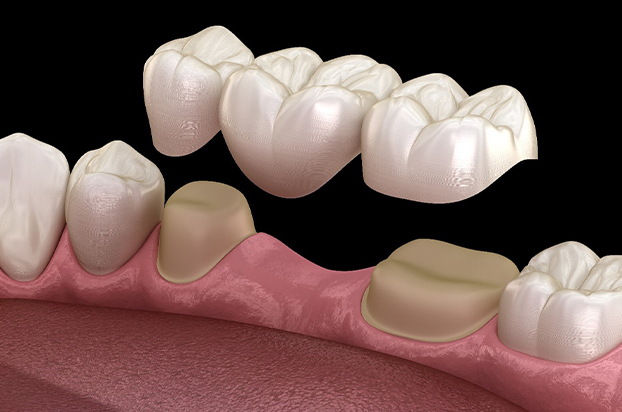Dental Bridges

Bridges for your teeth
Discovering the Benefits of a Dental Bridge
A dental bridge is a partial set of replacement teeth, typically made from porcelain to mimic the look and feel of natural teeth. Most dental bridges connect to adjacent natural teeth to provide support and prevent shifting caused by gaps from missing teeth. They are designed to be a permanent addition to the mouth and require healthy surrounding teeth or implants for proper support.
With proper care, dental bridges can last up to ten years. Dentists recommend brushing at least twice daily with a soft-bristled toothbrush, daily flossing around the teeth and bridge, and using an antiseptic mouth rinse. Patients may also be advised to use a proxabrush to clean under the bridge and to avoid tobacco products and hard, sticky foods like caramel.
“A dental bridge is a partial set of replacement teeth, usually made from porcelain that looks and feels like natural teeth.”
Individuals eligible for Dental Bridges
In order to receive a dental bridge, the patient must have some natural teeth remaining. Dental bridges are typically suitable for cases involving one or a few missing teeth, but may not be the best option if a large portion of the arch is missing. During a consultation, we can discuss different treatment options to determine the most effective solution for the patient.
It is important to note that the healing process for the gums after receiving a dental bridge can take up to six months, potentially causing a delay in treatment. Additionally, a bridge may not be feasible if there is insufficient bone or tooth matter to support it. Cedar Grove Dental Group can assess whether a patient is a suitable candidate for this procedure, and in some cases, a dental bridge may be just one part of a larger treatment plan or smile makeover.
“In general, dental bridges are appropriate for cases of one or a few missing teeth.”
Types of Dental Bridges
- Traditional: A traditional bridge consists of one or more replacement teeth supported by crowns on either side. The abutment teeth need to be slightly ground down, and the crowns are then placed over the natural teeth and cemented in place.
- Cantilever: Similar to a traditional bridge, but used when there is only one abutment tooth. It uses a cantilever design to secure the bridge from a single point.
- Maryland: The Maryland dental bridge connects to adjacent teeth using a metal framework that bonds to the inside of the natural teeth with resin, avoiding the need for crowns on the abutment teeth.
- Implant-Supported: These bridges are supported by dental implants that connect directly to the jawbone. Each replacement tooth typically has its own implant, which acts like a natural tooth root.
“There are four major types of dental bridges.”
Comparison between Dental Bridges and Dentures
“Dental bridges are more firmly rooted in place than dentures, which can make eating and speaking easier.”
Advantages of Dental Bridges
- Emulate Natural Teeth: The porcelain teeth on a dental bridge look, feel, and function like natural teeth. They are stable in the mouth, making them similar to natural teeth when eating and speaking.
- Allow Brushing: Patients can clean dental bridges in the mouth, unlike removable dentures, allowing them to brush and floss as usual. This familiar process makes oral care more manageable.
- Provide Value: Dental bridges are less expensive compared to implants and may cost more than removable dentures. Many patients find they offer a healthy balance between cost and effectiveness.
- Perform Effectively: Missing teeth can cause embarrassment and make speaking and eating more challenging. They may also lead to gradual jawbone erosion. A dental bridge effectively addresses these issues.




